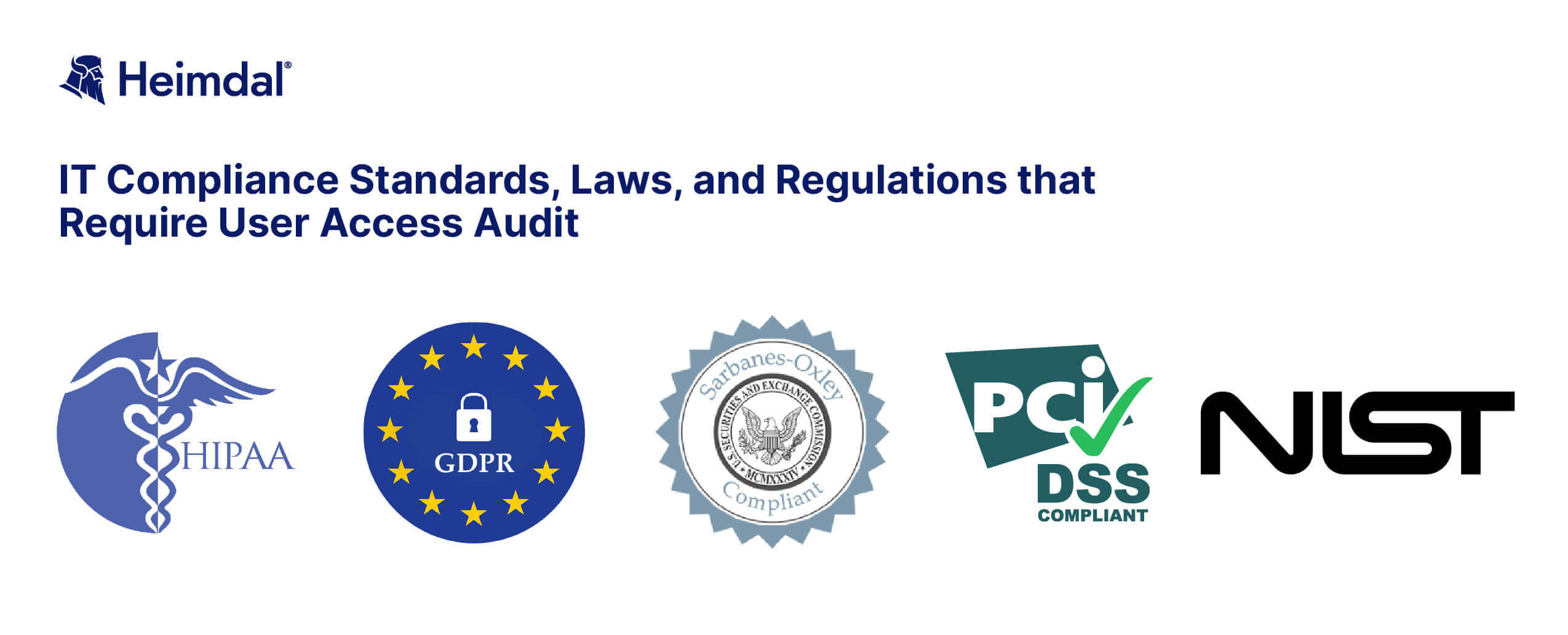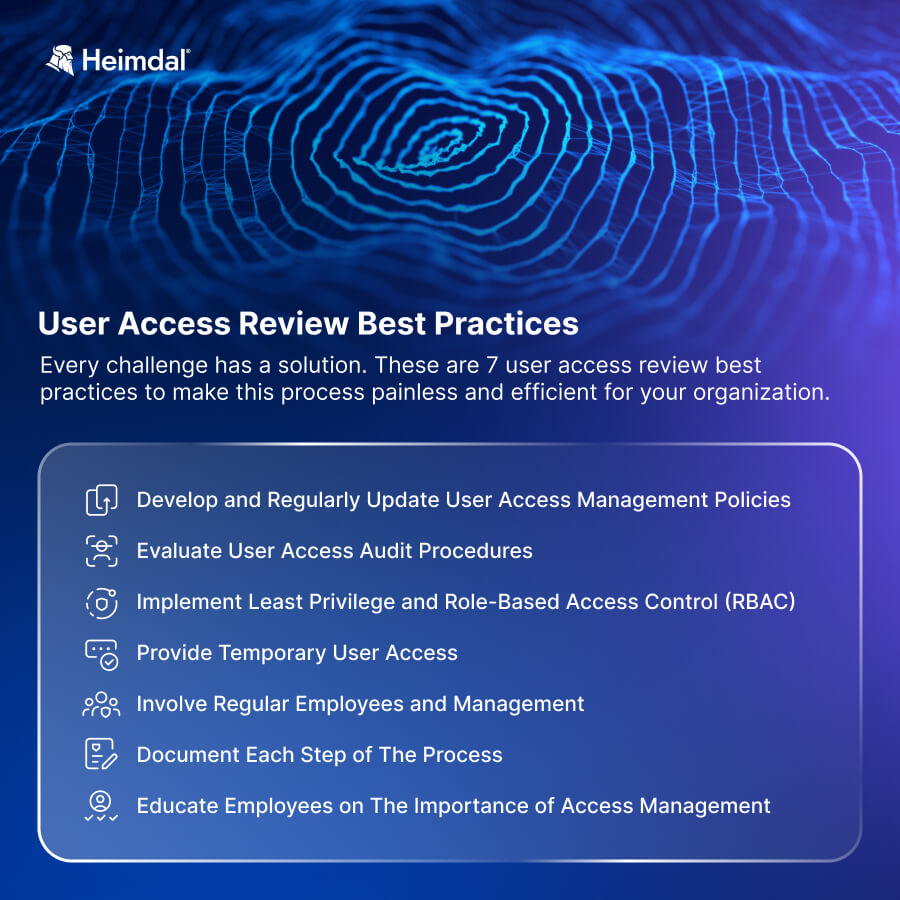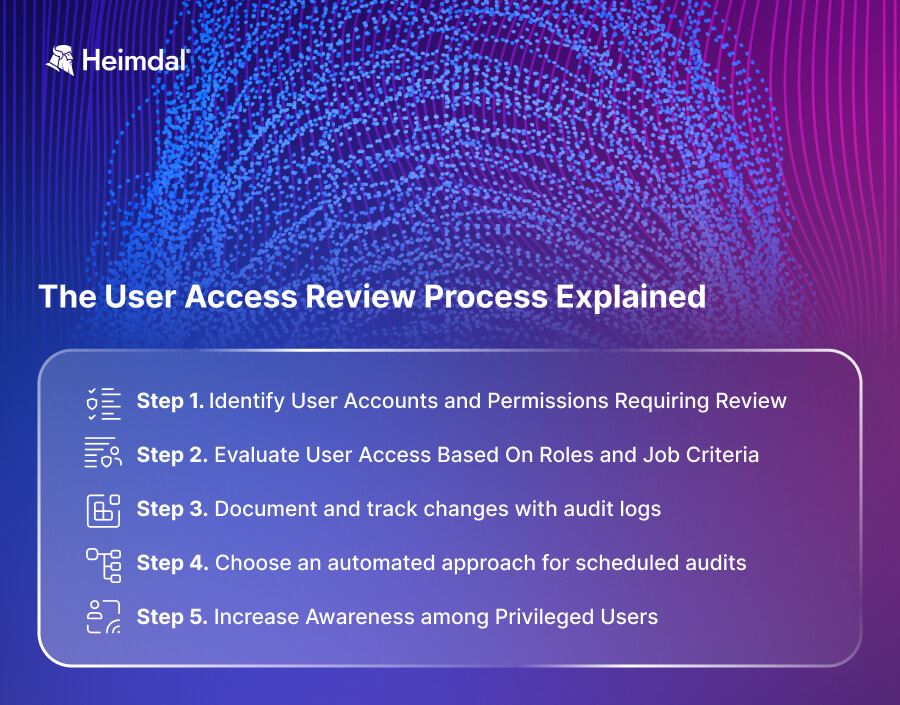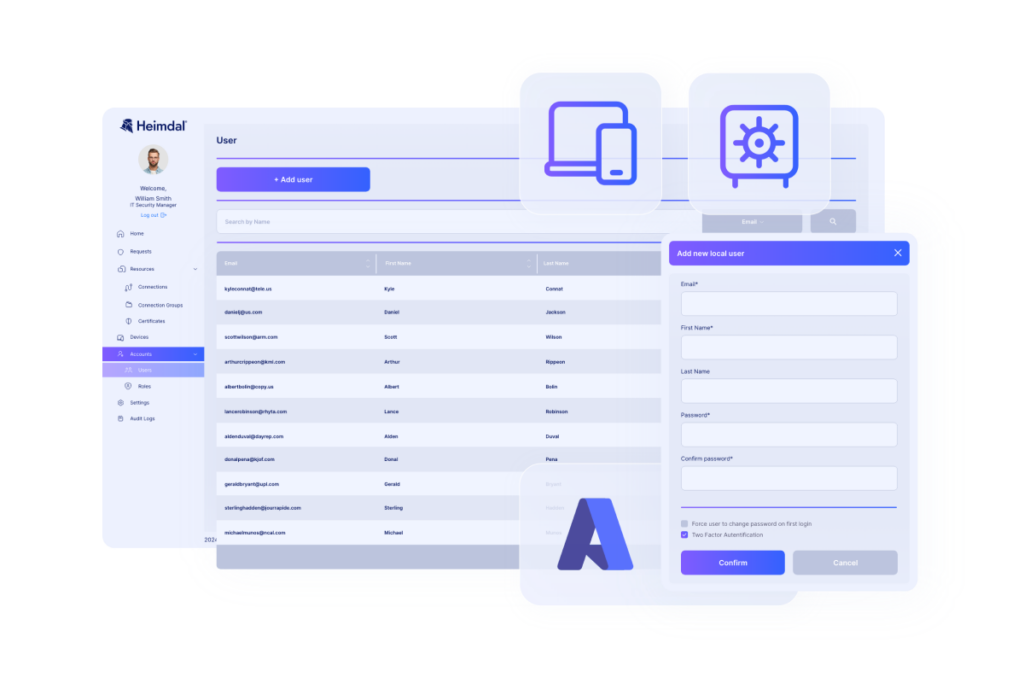Contents:
User access review is a common requirement of top compliance standards, including HIPAA, NIST, GDPR, PCI DSS, ISO 27001, and Cyber Essentials. Regular monitoring and control of who gets access to what in your organization’s system is a key part of securing sensitive data and critical assets.
Without a clear understanding of how to conduct these reviews, it’s easy to overlook risks that could expose sensitive information. This article covers everything you need to know about user access review, including:
- What Is User Access Review?
- Why Is User Access Review Necessary?
- Standards and Regulations Associated with User Access Review
- The Challenges of User Access Review
- Best User Access Review Practices
- The User Access Review Process Explained
- The User Access Review Checklist
- User Access Review and RBAC
What Is User Access Review?
The user access review process (UAR) refers to periodically reviewing each user’s privileges and access rights to all data and apps within an organization. It’s also known as access audit, entitlement review, account recertification, or account attestation, and is an important component of any organization’s Identity and Access Management (IAM) strategy.
It is important to note that here, the term “user” doesn’t only mean a company’s employees but everyone with whom your organization has any type of collaboration, including:
- Service providers;
- Third parties;
- Vendors.
User access review software ensures that a user’s access rights to an organization’s data and systems are appropriate for their role and tasks, and they don’t have access to any sensitive data that is not meant for their role.
The goal is to lessen security risks by restricting access to critical data and assets.
Also, despite incorporating security measures such as the Principle of Least Privilege, Zero Trust Policy, and Granular Access Management, skipping the access review process is not recommended.
Why Is User Access Review Necessary?
According to the “Privileged Access Management in the Modern Threatscape” report, 74% of data breaches originate from the misuse of privileged accounts.
Privileged accounts have more access rights to a computer system or network.
These accounts, generally assigned to sysadmins or IT professionals, have administrative privileges and can:
- change settings
- install software
- access sensitive data
- controll other user accounts
Due to their extensive privileges, these accounts make ideal targets for cybercriminals.
Common risks of privileged accounts
- Privilege creep: This happens when employees gain more access to sensitive data than is required over their time at a company, with additional privileges accruing as responsibilities increase.
- Privilege misuse: It occurs when insiders exploit authorized rights in unexpected ways, whether unintentionally, intentionally, or due to ignorance, posing cybersecurity risks.
- Privilege abuse: It is a fraudulent activity involving elevated privileges that allows criminal actors to access, compromise, or harm an organization’s secret assets, both by malicious insiders and outside attackers compromising privileged accounts.
So, robust security measures, such as regular user access reviews, are required to prevent unauthorized access and misuse.
Benefits of user access reviews
- Strengthening Security: Reviewing access permissions improves security by identifying and revoking unnecessary access, which reduces the risk of data breaches and insider threats. Rapid detection of anomalies enables proactive mitigation against potential security breaches or fraudulent activity.
- Ensuring Compliance: Conducting access rights reviews guarantee compliance with industry requirements and standards, such as HIPPA and ISO 27001, demonstrating a strong access management process that adheres to data protection principles.
- Boosting Efficiency: Regular access policy reviews increase efficiency for both IT professionals and end users by delivering the appropriate level of access without delay. This optimization reduces IT workload and expenses by removing or deactivating unused accounts, licenses, or subscriptions.
User access reviews are crucial for both security and operational efficiency. They help prevent security risks by ensuring that users don’t have more access than they need for their roles. This not only protects against potential breaches but also ensures that employees have the right tools for their jobs without unnecessary access.
Bogdan Dolohan, Head of Technical Support, Heimdal®
Standards and Regulations Associated With User Access Review
Depending on your industry and location, user access reviews may be required by regulation. The following are recommendations and mandates for access reviews based on essential security guides and regulations:

National Institute of Standards and Technology (NIST)
The NIST, a US government organization, publishes cybersecurity guidance without imposing restrictions. Organizations are required to examine their access rights and policies on a regular basis under controls AC-1 and AC-2 defined in NIST’s Special Publication 800-53. The framework provides businesses with the option to set their own review timetables and use specialist tools to ensure that the review process runs well.
Health Insurance Portability and Accountability Act (HIPPA)
HIPAA governs data protection in the healthcare industry in the United States. It requires a periodic assessment of access rules and procedures in accordance with HIPAA 164.308, Administrative Safeguards. The US Department of Health and Human Services conducts audits to ensure compliance with this requirement.
Payment Card Industry Data Security Standard (PCI DSS)
PCI DSS requires granular access control and periodic user role reviews for organizations that handle credit card and cardholder data (Requirement 7). Furthermore, an annual evaluation of access control measures is mandated under Requirement 12. The independence to assess the frequency and quality of these reviews rests with the organizations.
International Organization for Standardization (ISO 27001)
ISO 27001 allows enterprises to freely pick the scope and controls of their information security management system (ISMS). A periodic evaluation of access rights (5.18) is one of the recommended measures in Annex A that organizations should reference (6.1.3 c).
Sarbanes-Oxley Act (SOX)
SOX is a US law that governs access control procedures for digital documents in public accounting businesses, including user access reviews. An independent auditor performs an annual audit to ensure compliance. Specialized SOX compliance software is frequently used to help businesses comply with these regulations.
The General Data Protection Regulation (GDPR)
GDPR harmonizes data privacy rules across the European Union (EU) and applies to enterprises that collect and process personal data from EU residents. According to Article 32 of the GDPR, firms must audit the data they process as well as the people who have access to it. Non-compliance with this GDPR regulation may result in significant fines.
The Challenges of User Access Review
User access reviews are important to maintain a secure digital environment. However, it comes with a few challenges, which I’ll talk about in this section.

1. High Employee Turnover
With frequent employee turnover, tracking access privileges becomes difficult — which leads to a delay in the removal of access. Delayed revocation of access creates security issues because former employees may retain unnecessary access, increasing the organization’s risk to prospective threats.
2. Complex Information Technology Systems
Many businesses use sophisticated IT infrastructure, making it difficult to identify and audit all access permissions and rights. The complexities of modern IT environments can make it difficult to keep a comprehensive overview of access, increasing the risk of security gaps.
3. Insufficient Stakeholder Buy-In
Stakeholders’ lack of support and understanding can hinder the accessibility review process’s thoroughness and efficacy. Inadequate support may result in insufficient resource allocation, thus compromising the comprehensiveness of access reviews and security posture.
4. Multiple Identity Systems and Siloed Access Control
Managing access rights independently across systems can lead to inconsistencies, overprivileged accounts, and security risks. Siloed access control raises the danger of illegal access while complicating auditing processes, making it difficult to maintain a cohesive and safe access management system.
5. Certification Fatigue
Employees may become disengaged as a result of regular participation in various certification processes, which affects the focus on access control reviews. Employee fatigue may cause them to ignore critical components of access reviews, resulting in potential vulnerabilities and security flaws.
6. Rubber Stamping Access Control Requests
Approving access requests without a thorough examination owing to high volume, time restrictions, or limited resources creates a serious security risk. Rubber stamping increases the likelihood of providing too many rights, which contributes to data breaches, insider threats, and regulatory violations.
7. Lack of Access Control Tools
Organizations may lack visibility into the systems and apps that employees can access, making reviews time-consuming and error-prone. Without effective access control tools, the quality and efficiency of access assessments can be compromised, leaving possible security flaws unaddressed.
8. Meeting Compliance Requirements
Adhering to regulatory limits for safeguarding access permissions is difficult and varies by industry and location. Noncompliance can lead to legal implications and brand damage, stressing the significance of strong access controls in meeting regulatory standards.
9. Integration Gap Between IT and HR Systems
Manual reconciliation between IT and HR systems can lead to inaccuracies and inconsistencies in user identities and access rights. Integration flaws can lead to access discrepancies, perhaps allowing illegal access or keeping accounts active after an individual has left the organization.
User Access Review Best Practices
Every challenge has a solution. So, in this section, I’m sharing with you 7 user access review best practices to make this process painless and efficient for your organization.

Develop and Regularly Update User Access Management Policies
- Regularly update access management rules to reflect changes in organizational structure and data assets.
- Include a complete list of protected data and resources, user roles, access controls, and access management procedures.
- Consider using access management policy templates that are relevant to your industry and location.
Evaluate User Access Audit Procedures
- Maintain an up-to-date procedure for accessing user permissions.
- Create a review schedule, identify the accountable security officials, and establish notification periods for employees.
- Clearly specify the report’s contents and review results.
Implement Least Privilege and Role-Based Access Control (RBAC)
- Implement the Principle of Least Privilege access to ensure that users only have the access they need to perform their roles.
- Apply RBAC to assign access based on job responsibilities, simplifying access control and lowering the risk of unauthorized access.
Provide Temporary User Access
- Implement temporary access to limit the period of user permissions, therefore lowering the danger of internal and external attacks.
Involve Regular Employees and Management
- Engage employees and supervisors in the review process to ensure accuracy and speed.
- Seek feedback from employees and management on access privileges to accelerate the review process.
Document Each Step of The Process
- Maintain detailed records of the user permissions implementation process and create documentation assets.
- Facilitate compliance with laws and regulations, identify bottlenecks, and optimize the review process.
Educate Employees on The Importance of Access Management
- Conduct frequent cybersecurity awareness training to convey the principles and importance of access permission control.
- Train employees who conduct user access reviews to do so properly and in accordance with established regulations.
The User Access Review Process Explained
As you’ve understood the potential challenges associated with user access reviews and the best practices to overcome them, it’s time to conduct an effective user access review. Here’s how you can do it in 5 simple steps:

Step 1. Identify User Accounts and Permissions Requiring Review:
- Identify all user accounts in the organization.
- Check for discrepancies between permissions and job roles.
- Change access permissions as personnel, roles, or projects change.
- Customize access by deleting unneeded permissions and adding relevant ones.
Step 2. Evaluate User Access Based On Roles and Job Criteria:
- Evaluate user access rights based on established roles and responsibilities.
- Apply the principle of least privilege to offer only the grant minimal required access.
- Create an access hierarchy for restricted access depending on job roles.
- Simplify access management by defining clear responsibilities.
Step 3. Document and track changes with audit logs:
- Maintain detailed records of any changes to user access permissions.
- Keep track of who made modifications and when to ensure individual accountability.
- Use access change logs to spot patterns and trends.
- Improve access management on a continuous basis using log data insights.
Step 4. Choose an automated approach for scheduled audits:
- Implement automated audits at regular intervals (e.g., daily, weekly).
- Choose a suitable tool for scanning and assessing user accounts and access rights.
- Automation enables efficiency, precision, and continual monitoring.
- Adapt to corporate expansion while keeping auditing efficient.
Step 5. Increase Awareness among Privileged Users:
- Provide comprehensive details on the risks associated with elevated access.
- Provide regular security updates, policy changes, and reminders.
- Ensure that privileged users understand their roles in reporting and responding to breaches.
- Create an environment in which privileged users actively contribute to ensuring data and system security.
The User Access Review Checklist
A user access review process checklist aims to systematically analyse and optimize user access privileges while guaranteeing security, data integrity, and regulatory compliance.
Define the scope
Clearly define the apps and resources to be audited. This entails explicitly identifying the applications, systems, and resources under assessment. A clearly defined scope improves organization and structure, reducing errors and streamlining activities. Using risk assessment to prioritize high-risk accounts speeds up the review process.
Revoke Permissions of Ex-Employees
Check the status of access revocation for departed employees/service providers/third party vendors. During regular user access audits, emphasize the status of accounts associated with former workers. Keep a comprehensive log to ensure that their access privileges are terminated accurately and completely.
Enforcing Segregation of Duties (SOD) and Principle of Least Privilege
To reduce the possibility of fraud, implement SOD and the Principle of Least Privilege. To create checks and balances, assign duties and responsibilities to different people or teams. Allow individuals only the minimum level of access necessary to carry out specific job duties.
Implementing a Zero-Trust Approach for Privileged Accounts
Access to privileged accounts should be evaluated and monitored at regular intervals. To ensure consistency and avoid human errors, automate the privileged account management lifecycle using defined workflows. Establish expiry dates for privileged accounts and conduct regular assessments to detect unauthorized or abnormal activity.
Assessing Compliance with Security Policies
Identify inconsistencies and anomalies by monitoring and evaluating changes in user access rights. Prioritize the investigation of changes to user accounts, rights, and privileges. Take an active surveillance approach, using advanced tools to monitor system logs, network traffic, and user activity.
Document Review Process
Create and distribute the UAR report to stakeholders. The report should summarize the findings, outline highlighted issues, and give a complete analysis of the user access landscape. Share findings and recommendations with IT administrators, security specialists, and higher management.
User Access Review and RBAC
User Access Review process entails periodically reviewing individual user access rights, whereas RBAC, or Role-Based Access Control, is a security strategy that allows and restricts system access to employees or third party vendors based on their roles within an organization.
This strategy ensures that users have access to the essential data and programs to carry out their job responsibilities. It also reduces the possibility of unauthorized individuals accessing sensitive information or engaging in unauthorized tasks and makes it easier to review and manage user access.
For example, marketing professionals have access to only marketing tools such as web analytics and content management systems (CMS), whereas finance professionals have access to billing systems and accounting software.
User access reviews are important for maintaining the integrity of RBAC. They help ensure that the roles and permissions are still accurate and relevant, preventing issues like privilege creep and ensuring that users have access rights that match their current job requirements.
Bogdan Dolohan, Head of Technical Support, Heimdal®
Beyond access limitation, RBAC shapes the user’s interaction with data by granting specific roles read-only or read/write access — limiting the user’s capacity to execute commands or remove information.
If an employee’s role changes, role group memberships may need to be adjusted accordingly. Adding a user to a role group gives them access to all of the associated permissions, while removing them restricts access.
Temporary access to specific data or programs can be granted for the purpose of completing a task and subsequently revoked.
Conclusion
Conducting user access reviews is an important step in the access management process. This approach helps to reduce cybersecurity risks for your organization by eliminating unnecessary access to key resources and limiting users’ privileges to the minimum required.
Privileged accounts are highly appealing targets for threat actors, and they should be monitored closely. This is where Heimdal® will make a difference for your organization.
Heimdal®’s Privileged Access Management PAM solution is the only tool on the market that automatically de-escalates users’ rights on threat detection and at the same time makes you achieve two vital things: full compliance, being NIST AC-5 and NIST AC-1,6 compliant, and also increased productivity.
Moreover, a cool centralized dashboard will allow your sysadmins to manage access granting efficiently and offer you a complete overview of your users’ activity.

Heimdal® Privileged Access Management
- Automate the elevation of admin rights on request;
- Approve or reject escalations with one click;
- Provide a full audit trail into user behavior;
- Automatically de-escalate on infection;
Combine it with Application Control for app, user & process throttling or with Next-Gen Antivirus for a secondary security shield. Heimdal® Privileged Access Management streamlines and secures your rights management flows and can be combined with more Heimdal® products to deliver an authentic Endpoint Prevention, Detection and Response (EPDR) stance.
This article has given you a comprehensive overview of the user access review process so that you can leverage it for your organization’s cybersecurity.
FAQs
What is the purpose of a user access review?
The purpose of reviewing user access rights is to limit the number of individuals who can access data and reduce the risk of a data breach and associated cybersecurity risks.
Who is responsible for user access review?
The application’s IT owner is responsible for ensuring that the user access review control works properly for IT users. The owner can delegate this activity, but the application’s IT owner is still responsible for this control and any violations.
What is the impact of user access review?
As part of a risk-based approach to IT governance, regularly reviewing user access rights evaluates your users’ level of authority for various systems, assisting you in mitigating cybersecurity risk and insider threats.
If you liked this article, follow us on LinkedIn, Twitter, Facebook, and Youtube.










 Network Security
Network Security
 Vulnerability Management
Vulnerability Management
 Privileged Access Management
Privileged Access Management  Endpoint Security
Endpoint Security
 Threat Hunting
Threat Hunting
 Unified Endpoint Management
Unified Endpoint Management
 Email & Collaboration Security
Email & Collaboration Security












